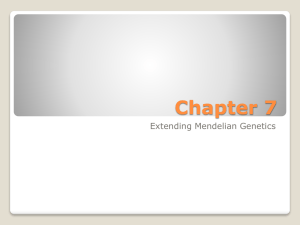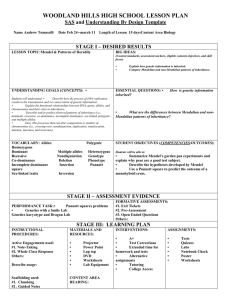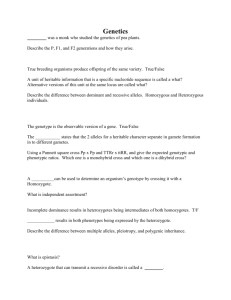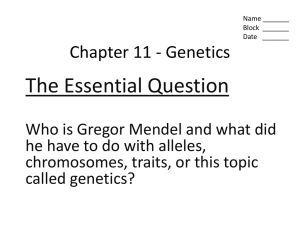Ch. 14 The Human Genome-Section 3
advertisement
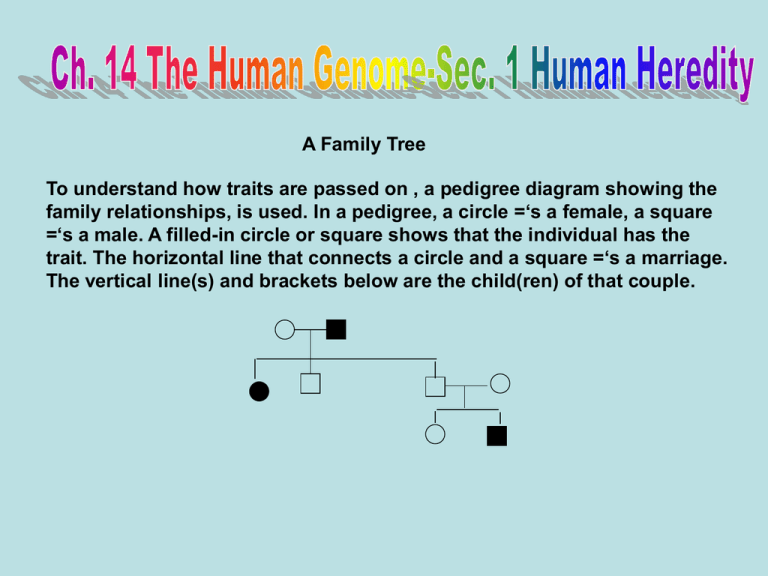
A Family Tree To understand how traits are passed on , a pedigree diagram showing the family relationships, is used. In a pedigree, a circle =‘s a female, a square =‘s a male. A filled-in circle or square shows that the individual has the trait. The horizontal line that connects a circle and a square =‘s a marriage. The vertical line(s) and brackets below are the child(ren) of that couple. 1. This pedigree shows the inheritance of attached ear lobes. Which parent has attached ear lobes? 2. How many children do the parents have? Which child has attached ear lobes? 3. Which child is married? Does this child’s spouse have attached ear lobes? Do any of this child’s children have attached ear lobes? 14–1 Human Heredity A. Human Chromosomes 1. Karyotype a. autosomes b. sex chromosomes Making a Karyotype activity http://learn.genetics.utah.edu/u nits/disorders/karyotype/kar yotype.cfm B. Human Traits- Click to see pedigree chart C. Human Genes 1. Blood Group Genes Click to see slide 2. Recessive Alleles Click here for concept map 3. Dominant Alleles of these 3 alleles 4. Codominant Alleles D. From Gene to Molecule 1. Cystic Fibrosis Click here for slide 2. Sickle Cell Disease Click here for slide Click button if you want to go directly to the next section A circle represents a female. A horizontal line connecting a male and female represents a marriage. A half-shaded circle or square indicates that a person is a carrier of the trait. A completely shaded circle or square indicates that a person expresses the trait. A square represents a male. Click here to return to previous slide A vertical line and a bracket connect the parents to their children. A circle or square that is not shaded indicates that a person neither expresses the trait nor is a carrier of the trait. Phenotype (Blood Type Genotype Safe Transfusions Antigen on Red Blood Cell To Click here to return to outline From Autosomal Disorders Concept Map Click to return to outline caused by Recessive alleles Albinism Galactosemia Dominant alleles TaySachs disease Codominant alleles Huntington’s Sickle cell AchondroCystic fibrosis Phenylketonuria plasia Hypercholesterolemia Chromosome # 7 Normal CFTR is a chloride ion channel in cell membranes. Abnormal CFTR cannot be transported to the cell membrane. The most common allele that causes cystic fibrosis is missing 3 DNA bases. As a result, the amino acid phenylalanine is missing from the CFTR protein. Click here to return to outline The cells in the person’s airways are unable to transport chloride ions. As a result, the airways become clogged with a thick mucus. 20% of African Americans are carriers for sickle cell disease. Children who receive a recessive gene from each parent can become blind. Arms and legs can become paralyzed or even die. Strokes and heart attacks are common. Treatments are available to decrease the complications of this disease but there is no cure. Many African Americans will ask to be tested to see if they have one of these genes in their chromosomes. Button takes you to next section. Gender Benders You may remember that in humans, the sperm cells may carry an X chromosome or a Y chromosome, while egg cells have only X chromosomes. Sometimes, errors during meiosis in one of the parents produce offspring with an abnormal number of sex chromosomes. 1. On a sheet of paper, construct a Punnett square for the following cross: XX x XY. Fill in the Punnett square. What does the Punnett square represent? According to the Punnett square, what percentage of the offspring from this genetic cross will be males? What percentage will be females? 2. On a sheet of paper, construct a Punnett square for the following cross: XXX x XY. Fill in the Punnett square. How is this Punnett square different from the first one you constructed? What might have caused this difference? 3. How do the offspring in the two Punnett squares differ? 14–2 Human Chromosomes A. Human Genes and Chromosomes Click for nondisjunction slide B. Sex-Linked Genes 1. Colorblindness Click for punnett square slide 2. Hemophilia http://www.ygyh.org/hemo/whatisit.htm 3. Duchene Muscular Dystrophy http://www.ygyh.org/dmd/whatisit.htm C. X-Chromosome Inactivation The coloration of tortoiseshell cats is a visible manifestation of Xinactivation. The "black" and "orange" alleles of a fur coloration gene reside on the X chromosome. For any given patch of fur, the inactivation of an X chromosome that carries one gene results in the fur color of the other, active gene. Click to go to next part of outline D. Chromosomal Disorders 1. Down Syndrome- site has interactive slide show of how this syndrome occurs http://learn.genetics.utah.edu/units/disorders/karyotype/downsyndro me.cfm 2. Sex Chromosome Disorders A. Turner’s site has interactive slide show of how this syndrome occurs http://learn.genetics.utah.edu/units/disorders/karyotype/turnersyndro me.cfm B. Kleinfelter’s site has interactive slide show of how this syndrome occurs http://learn.genetics.utah.edu/units/disorders/karyotype/klinefelter.cf m Click to go to next part of outline Homologous chromosomes fail to separate Homologous chromosomes fail to separate Meiosis I: Nondisjunction Homologous chromosomes fail to separate Meiosis I: Nondisjunction Click to return to outline. Meiosis II Father (normal vision) Normal Colorblind vision Male Female Daughter (normal vision) Mother (carrier) Click to return to outline Normal Colorblind vision Male Female Mother (carrier) Father (normal vision) 14–3-Human Molecular Genetics A. Human DNA Analysis 1. Testing for Alleles Click for next part of outline http://www.accessexcellence.org/AE/AEPC/NIH/gene09 .html Different types of genetic tests are used to hunt for abnormalities in whole chromosomes, in short stretches of DNA within or near genes, and in the protein products of genes. 2. DNA Fingerprinting-an on line interactive lab (takes 45 minutes, may wish to assign for home) http://www.pbs.org/wgbh/nova/sheppard/analyze.html DNA Game- quick look at how DNA fingerprinting can solve a crime http://library.thinkquest.org/C0125833/english/whodunit.php Click to go to next slide B. The Human Genome Project-This link is to the HGP home page http://www.ornl.gov/sci/techresources/Human_Genome/ho me.shtml 1. Rapid Sequencing 2. Searching for Genes Click to go to slide 3. A Breakthrough for Everyone – public knowledge and access. See above link. Click to continue outline Sequences can locate genes. Intron Click to return to outline Start codon Promoter Insulin gene Stop codon C. Gene Therapy Gene therapy using a virus. A new gene is inserted into a virus, which is used to introduce the modified DNA into a human cell. If the treatment is successful, the new gene will make a functional protein. D. Ethical Issues in Human Genetics



